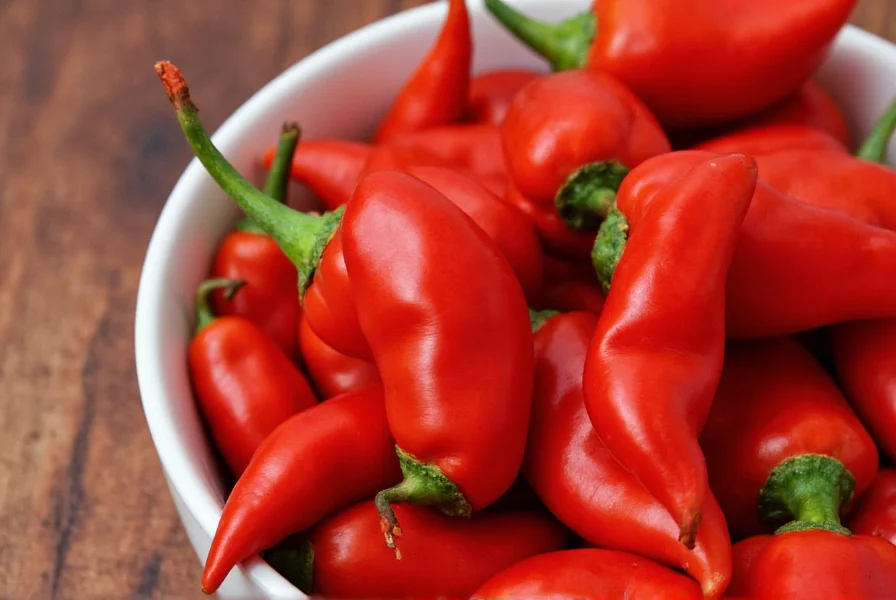Understanding pepper heat levels starts with grasping how the Scoville scale works. Originally, Scoville measured heat through a subjective dilution test where trained tasters determined how much sugar water was needed to neutralize a pepper extract's burn. Today, laboratories use precise HPLC testing to measure capsaicinoid concentration in parts per million (ppm) and convert results to Scoville Heat Units using the standard formula: SHU = ppm × 15 (Chile Pepper Institute), providing more accurate and consistent measurements across different peppers.
How Scoville Heat Units Translate to Real-World Experience
The numerical value on the Scoville scale directly correlates with perceived heat intensity. Here's what different ranges mean for your palate:
- 0-100 SHU: No detectable heat (bell peppers)
- 100-2,500 SHU: Mild heat (pimento, banana peppers)
- 2,500-8,000 SHU: Medium heat (jalapeños, serranos)
- 8,000-50,000 SHU: Hot (cayenne, tabasco peppers)
- 50,000-100,000 SHU: Very hot (habaneros, Scotch bonnets)
- 100,000-350,000 SHU: Extremely hot (ghost peppers)
- 350,000+ SHU: Dangerously hot (Carolina Reaper, Pepper X)
| Pepper Variety | Scoville Heat Units (SHU) | Heat Level Description |
|---|---|---|
| Bell Pepper | 0 | No heat |
| Poblano | 1,000-2,000 | Mild, earthy |
| Jalapeño | 2,500-8,000 | Moderate, bright heat |
| Serrano | 10,000-23,000 | Sharp, immediate heat |
| Cayenne | 30,000-50,000 | Intense, lingering burn |
| Habanero | 100,000-350,000 | Explosive, fruity heat |
| Ghost Pepper | 855,000-1,041,427 | Severe, long-lasting burn |
| Carolina Reaper | 1,400,000-2,200,000 | Extreme, medically significant heat |
Factors That Influence Pepper Heat Levels
Several variables affect where a specific pepper falls on the Scoville scale:
Environmental conditions significantly impact heat intensity. Peppers grown in stressful conditions—such as limited water, higher temperatures, or nutrient-deficient soil—typically produce more capsaicin as a defense mechanism. The Chile Pepper Institute documents that identical jalapeño plants can vary by 300% in SHU under different conditions (Chile Pepper Institute). For example, a jalapeño might measure 2,500 SHU in ideal growing conditions but reach 8,000 SHU when stressed.
Ripeness also plays a crucial role. As peppers mature and change color (from green to red, orange, or yellow), their capsaicin concentration generally increases. A red jalapeño is typically hotter than its green counterpart. The placenta (white ribs inside the pepper) contains the highest concentration of capsaicin, while the seeds themselves have minimal heat.
Practical Applications of Scoville Knowledge
Understanding scoville heat units explained helps home cooks and professional chefs make informed decisions. When substituting peppers in recipes, knowing approximate SHU ranges prevents unintentionally creating dishes that are too mild or dangerously hot. For instance, replacing jalapeños (2,500-8,000 SHU) with habaneros (100,000-350,000 SHU) without adjustment would create an overwhelmingly spicy dish.
Safety considerations become critical when handling extremely hot peppers. Capsaicin is oil-based and doesn't wash away with water. Chefs working with ghost peppers or Carolina Reapers should wear gloves and avoid touching their face. If exposed, dairy products like milk or yogurt provide relief by binding to capsaicin molecules, while water merely spreads the compound.

Common Misconceptions About the Scoville Scale
Many people misunderstand how scoville unit conversion works. The scale doesn't measure temperature but rather the concentration of capsaicinoids. Another misconception is that higher SHU always means better flavor, but many culinary applications benefit from moderate heat levels that enhance rather than dominate the dish.
The original Scoville Organoleptic Test had significant limitations due to human taste variation. Modern HPLC testing provides objective measurements, but the results are still converted to Scoville units for public understanding. This conversion explains why you might see slight variations in reported SHU values for the same pepper variety across different sources.
Contextual Limitations of Heat Perception
The Scoville scale measures chemical concentration but doesn't account for real-world consumption variables:
- Individual Physiology: Genetic variations in TRPV1 receptors cause significant differences in heat perception. A 2013 study in Pain journal found people with specific genetic markers experience 40% higher pain intensity at identical SHU levels (Source: NIH).
- Food Matrix Effects: Fat content and pH dramatically alter heat perception. Penn State Extension research shows capsaicin binds to casein in dairy, reducing perceived heat by 60-70% in creamy sauces (Source: Penn State).
- Preparation Methods: Removing seeds/membranes reduces heat by up to 90%, while drying concentrates capsaicin. A fresh habanero (100,000-350,000 SHU) becomes 15x hotter by weight when dehydrated.
These factors explain why two peppers with identical SHU ratings may produce vastly different experiences depending on preparation and consumer biology.
Historical Evolution of Measurement Methods
The journey from subjective tasting to laboratory precision reveals critical advancements in pepper science:
| 1912 | Wilbur Scoville develops the Organoleptic Test at Parke-Davis pharmaceutical company. Human tasters diluted pepper extracts until heat became undetectable, creating the first standardized heat measurement (Source: University of Vermont Extension). |
| 1980s | High-performance liquid chromatography (HPLC) emerges as the scientific standard. This objective method precisely measures capsaicinoid concentration, eliminating human taste variation (Source: American Chemical Society). |
| 2000s | ASTM International standardizes HPLC protocols (ASTM E2424). Results are mathematically converted to SHU using SHU = ppm × 15, maintaining historical continuity while ensuring accuracy (Source: Chile Pepper Institute). |
| 2013 | Carolina Reaper certified as world's hottest pepper (1,400,000-2,200,000 SHU) using HPLC validation, demonstrating the scale's capacity to measure previously unimaginable heat levels (Source: Guinness World Records). |
This progression enabled the development of record-breaking peppers while providing consumers with reliable heat benchmarks.











 浙公网安备
33010002000092号
浙公网安备
33010002000092号 浙B2-20120091-4
浙B2-20120091-4